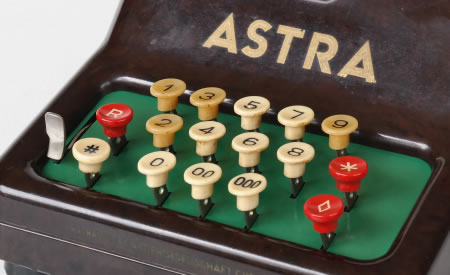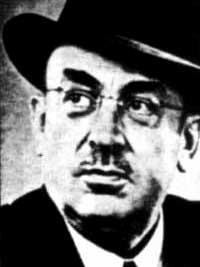Some Astra calculators were equipped with electric and manual drive. The entered number, the + or - signs and total signs are printing in a two colors mode on a paper roll (Negative amounts are printed in red). This made control of the results afterwards much easier. The electric motor was attached outside to the rear of the machine.
In 1929, after being eight years on the market, Astra was one of the European market leaders for adding machines. At those days the Astra company labored 407 employees, which drastically grew to 1,800 in 1938.
Before and during the Second World War the Astra company was forced to participated in arms production for Nazi Germany. After the war in 1945, the Soviets have completely dismantled the plants and founder Mr. Greve was dismissed.
Mr. Greve moved to Cologne in 1948 where he tried, at advanced age, to establish "Exacta Buromaschinen GmbH". In 1955 the formal relocation of Astra Company to Cologne took place and cooperate with manufacturer Kienzle was setting up. But it still did not get the desired results and Mr. Greve resigned from the company in 1963 and he died in Düsseldorf in 1967.
In 1948, the GDR times, the Astra Company is renamed a number of times. First to "VEB Astra Werke" (VEB is the abbreviation for the GDR state company structure: Volks Eigener Betrieb, in English Factory Owned to the People). This was later renamed "Mechanic Astra Company VEB".
In 1948 they started, a for that time very advanced modular design approach, with Klasse 110 until 170. The features of the machine range, spans from adding and listing-, with multiplication possibilities, until a very advanced bookkeeping machines. These where technical advanced products using durable materials; have a high level of standardization of components and became very reliable, maintenance friendly and sophisticated machines. The production started in 1953 and the machines had a modern designed outlook and won several design prices. The 110 is considered as the new generation mother type, where several products arise from. All these gave Astra and a good market position and a highly accepted and good reputation in the world.
Five highlights, Class / Klasse:
- 110 a single 12 digit calculator with a repeat function for manual multiplication
- 116. Is a longer 110 with two separate calculators units. Used as daily and weekly sum results in cash registers
- 117 small bookkeeping machine
- 114, 314 calculator with automatic multiplication (manufactured at VEB Robotron-Secura Werke Berlin (logo: DARO))
- 170 (with Klasse 120, 130, 140, and 150 as pre successors) The 170 is a advanced bookkeeping machine with many options in terms of memory (5 until 55 separate numbers) and periphery units like paper tapes and external memory etc. 200,000 bookkeeping machines were produced between 1955 and 1978
Astra and the Continental part of Wanderer merged in 1953 into the "VEB Büromaschinenwerk". It was not a very successfully corporation. Wanderer people had opposition against the Astra products, some old hesitations. That's why they were separated already a year later. As consequence of the struggle the production of Wanderer Continental was moved to Optima in Erfurt
and the Continental development, which had brought no "new" successes, stopped as well in 1954 in Chemnitz.
In 1954, Chemnitz had been renamed "Karl-Marx-Stadt" by the GDR administration. The company name changed to "VEB Buchungsmaschinenwerk Karl-Marx-Stadt" consequently.
In 1959 it was not possible to use the trademark "Astra" any more in the GDR. The new name "Ascota" (Astra + Continental Tastatur) was chosen. A bit strange name, knowing the struggle on the keys dispute
1969 Merged in the Kombinat Zentronic, like Triumphator-Mölkau
1973 the staff peak was reached with more than 10,000 employees.
1978 the company was merged in the Kombinat Robotron, and renamed in "VEB Robotron Buchungsmaschinenwerk Karl-Marx-Stadt" and produced office computer.
1990 At the reunification of Germany ("Karl-Marx-Stadt " had became Chemnitz again) The "Robotron Ascota AG Chemnitz", had no future prospective and is liquidated in the years 1991-1993.
This meant the end of 70 years of "Office machine" design and manufacturing in Chemnitz.
More details
*)1 I left out the electronic calculator and computer related products, due to the mechanical calculator emphasis of this web side.
The digits were not yet resigned in the order we have nowadays. Instead the numbers were arranged in two rows of the keyboard 1-9, within which was the sequence of digits in a zigzag line. They had as well the following buttons:
(#) not add key, for numbers and date entries
(R) a repeat (holts the input number)
(*) a summation
(◊) a subtotal key
In addition, there was left of the keyboard a delete lever and the number of entered digits are indicated by a pointer in a window above the keyboard.
Mr. Greve took his decision to leave Wanderer and started his Astra company in 1921.
The "Astra" calculators are all based on the "Oscillating Rack or Rocking Segment" calculating technology and had the advanced numeric 10 key-keypad, which had for the first time additional buttons "00" and "000" beside the keys for the digits 0 to 9. With these extra buttons a higher input speeds could be achieved.


